What is sympathetic joy? Imagine how a loving parent feels seeing their child giggle in playful delight, or rock their spotlight in the school play. Sympathetic joy is about feeling uplifted, connected, and endeared when something wonderful is happening to another person, and it can involve the urge to approach and offer affectionate, nurturing touch like a hug.

The concept of sympathetic joy has origins in Buddhism, where feeling glad, contented, and affiliative in response to good things happening to other people, or in witness to other people’s happy expressions, is a core aspirational virtue (and one of the four immeasurables of loving-kindness). Sympathetic joy is often contrasted with jealousy, or feelings of competitiveness or inadequacy, that come up when we compare ourselves to others who are celebrating, being honored, or experiencing greatness. Not only does sympathetic joy feel better than the aforementioned alternatives, but as a 2019 paper in the journal Mindfulness suggests, it can strengthen social connections, make relationships more satisfying, and contribute to greater happiness in life.
Sympathetic joy is an innate capacity. We spontaneously mirror each other’s enjoyment, like when babies smile back or laughter spreads through a room even though folks don’t know where the funny started. Like many interpersonal skills, however, the amount of sympathetic joy that people experience in life can differ by individual characteristics, life circumstances, and day-to-day habits of thought, experiences, and behaviors.
How often do Greater Good’s readers experience sympathetic joy? Between January 1, 2023, and March 18, 2024, 2,179 people took the GGSC’s sympathetic joy quiz, choosing responses on a scale from “Almost Never” to “Almost Always” for questions like: “When I see another’s wish finally come true, I often have the feeling of ‘How wonderful this is,’” and “I feel joyful when I see other people immersed in their happiness.”
Questions on this quiz were drawn from a validated measure which was published in a 2017 paper called Development of the Appreciative Joy Scale, by a team of researchers from China, Hong Kong, and Australia. After the 13 questions included in the sympathetic joy quiz, we asked questions about age, ethnic identity, gender, income, political view, religiousness/spirituality, and feelings of connection with people in general. We analyzed quiz scores according to these factors to explore how associated they were with average levels of sympathetic joy.
Sympathetic joy scores rise with age
Quiz-takers who indicated being under 18 years old reported the least experience of sympathetic joy. That increased for people in their 20s, followed by a slight upward trend for people in their 30s and 40s. People in their 50s and 60s reported stepwise increases in sympathetic joy, followed by a decline among people 70 or older. This pattern of age-related increase in feelings of sympathetic joy among our voluntary pool of GGSC quiz-takers is consistent with the trajectory of another psychological tendency that is linked to well-being: generativity. That’s the inclination to act in ways that promote the well-being of younger generations, which one 2021 paper links to more well-being in older adults.
Why do people in the 70-and-older group show a decline in experiences of sympathetic joy? While our data cannot reveal insights into the causes of this decline, it is possible that people in this group have fewer opportunities to share space and time with other people, in good times or bad, or they may be experiencing more difficulty with physical comfort, mobility, and sleep, circumstances that also could reduce their capacity to embrace joy in others.
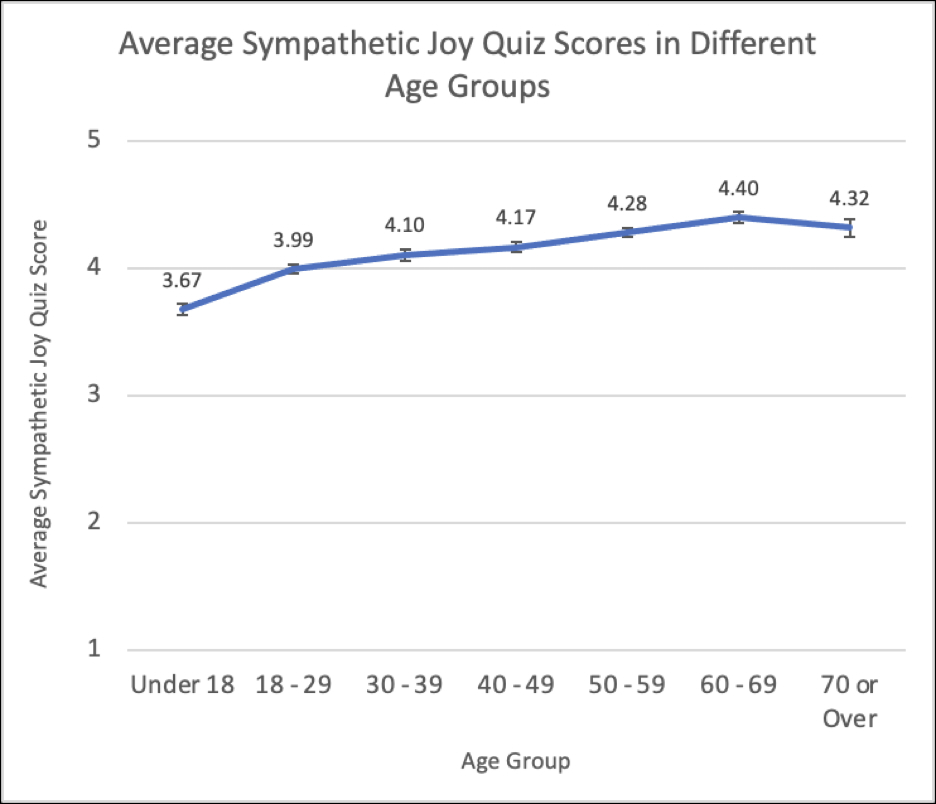
Women score higher than other gender identities
Typical of most GGSC quizzes, 68% of those who took the sympathetic joy quiz were female. Of the remaining, 27.4% selected male, and 4.6% selected non-binary or “prefer to self-identify.” Female quiz-takers, on average, reported experiencing it more often than other gender-based groups, which is also typical with our quizzes. This pattern is not evidence or proof that females have more sympathetic joy. Rather, it suggests that female visitors to the GGSC’s sympathetic joy quiz may be more interested in it, more likely to recall having experienced it, and more motivated to describe themselves that way. This could be related to complying with gender-based cultural expectations, or fulfilling identity-based goals. It could suggest a more basic sex difference, but that is very hypothetical and not at all shown by results from this quiz.
While the score for quiz-takers who selected non-binary or prefer to self-identify appears to be lower, it is statistically equivalent to the average score for male quiz participants.
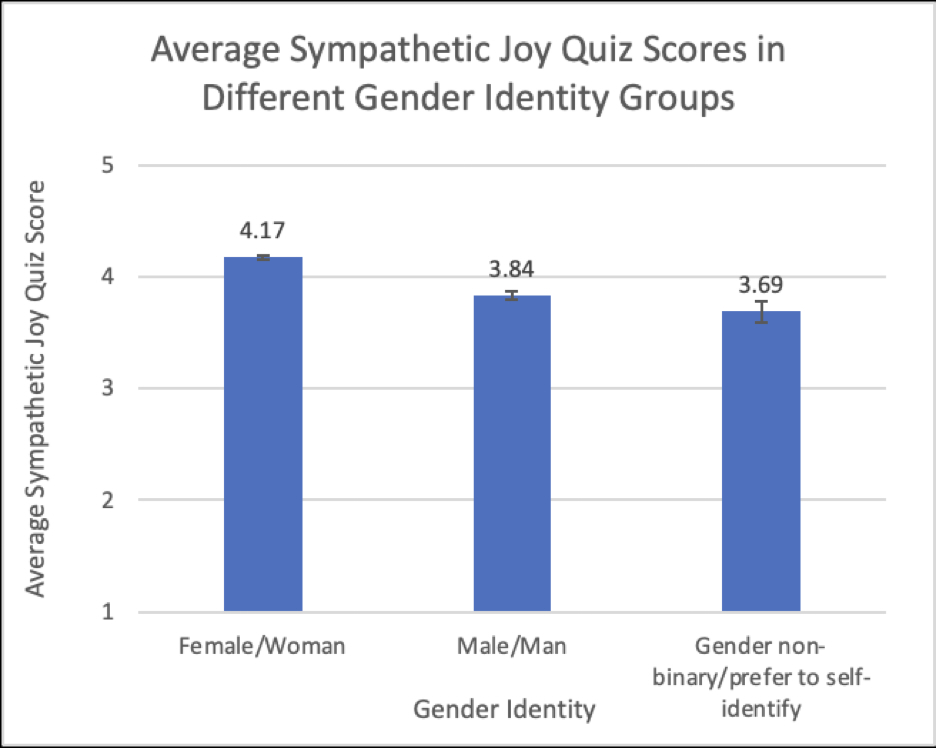
Income and political views don’t really matter
The pattern of sympathetic joy differences between people in low and high income brackets is inconclusive. While there were small differences between the lowest and low-middle income categories, with lower scores among people reporting less than $25,000 annually compared to people making between $50,000 and $100,000 annually, the pattern drops back down and stays flat thereafter. While it may be plausible to interpret that very low income, or financial distress, can get in the way of sympathetic joy, nothing in this data suggests that higher income has a systematic influence. As for political orientation, the line from very liberal to very conservative was unremarkably flat, suggesting that people with different political ideals experience sympathetic joy to similar degrees.
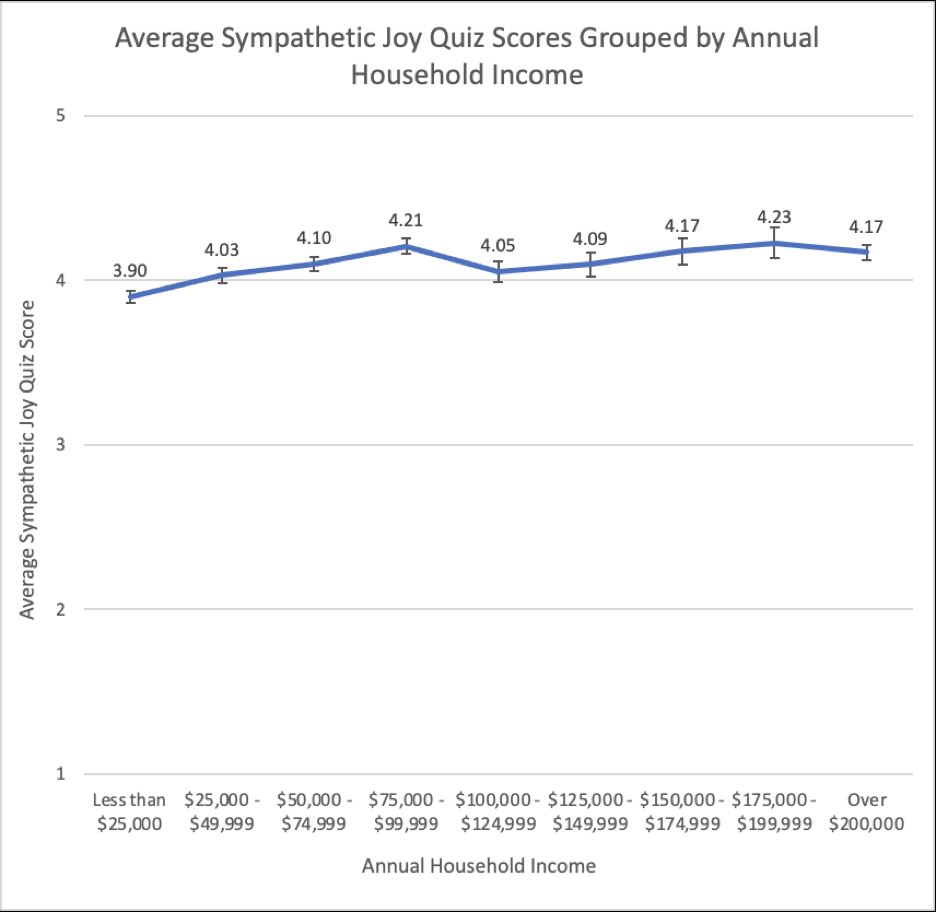
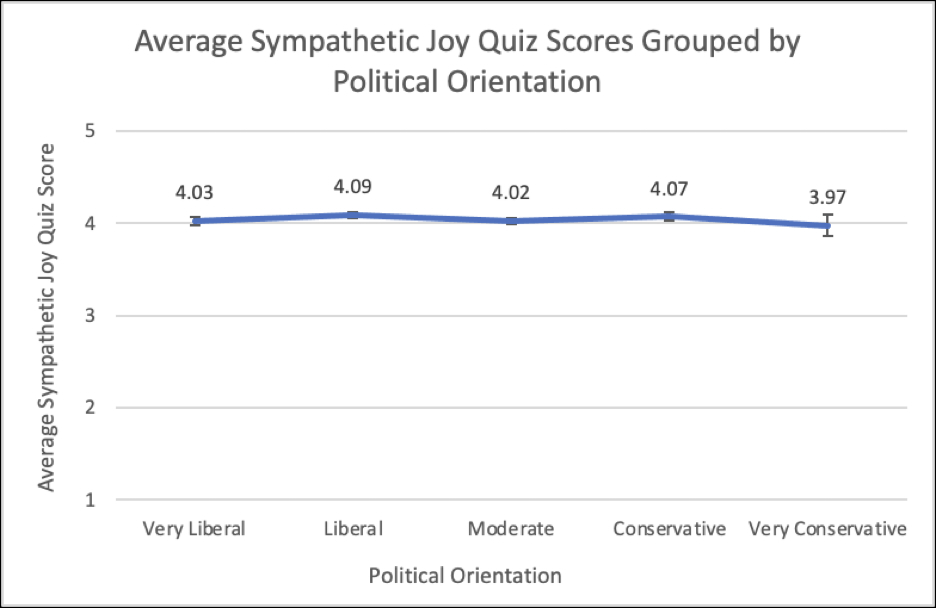
Neither does race (maybe)
We weren’t able to draw strong conclusions from the data about ethnicity. Over 200 people who finished the quiz chose not to answer this question. That could be because the choices offered didn’t feel like a good fit. In addition, there were too few quiz-takers who selected Native American, Middle Eastern, and multiethnic (less than 100) to confidently include their scores in this analysis. Though self-described whites scored slightly higher in sympathetic joy than the other three major ethnic groups, a deeper look at response patterns for individual questions on the quiz reveals some interesting nuances.
For example, Black people reported experiencing the following more often than any other ethnic group: “Even if my friends or family are better than me at something, I am still quite willing to see them succeed”; “I still have the ability to share in other people’s happiness even when I am going through bad times”; and “I feel blissful for the celebrations of friends or family, such as weddings and birthdays.” Could it be that some aspects of sympathetic joy resonate more strongly with people and communities with certain cultural identities? Could it be that the language and style of the questions themselves make more sense to some people than others and, as written, fail to fully capture the true experience of sympathetic joy? If so, we’d get better answers with more inclusive (or more targeted) psychological assessments, as this 2023 article argues.
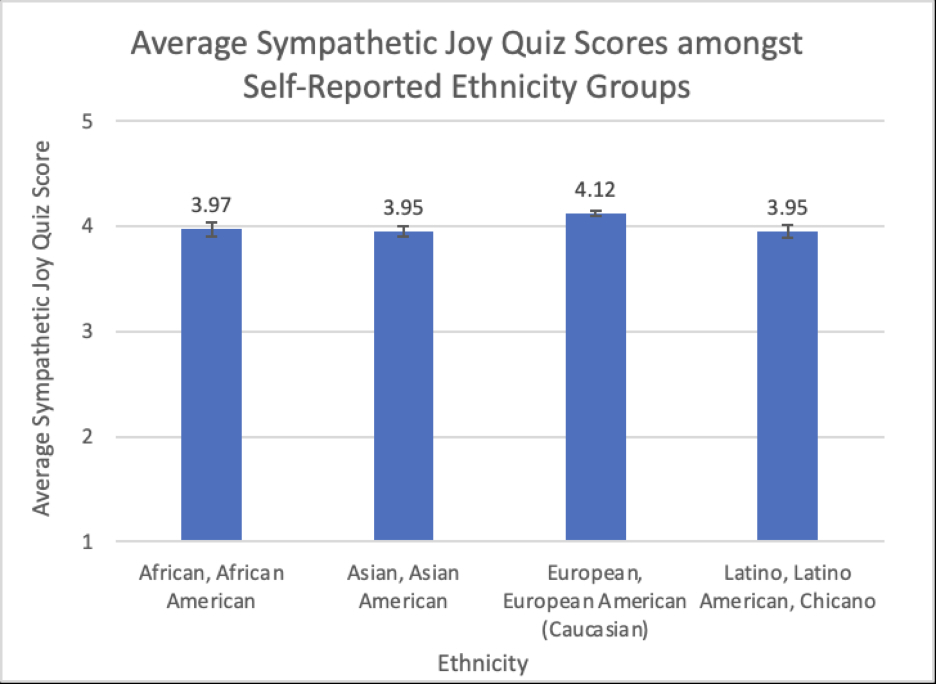
Scores are higher for people who feel more spiritual/religious, or more connected to humanity
For each increase in response to the statement “How religious or spiritual are you?,” there was a concurrent increase in sympathetic joy. Many religious and spiritual traditions espouse the virtue of sympathetic joy, and many have specific rituals that involve behaving as such. These experiences may explain why people who see themselves as more religious or spiritual also score higher in sympathetic joy.

The strongest link with sympathetic joy occurred in people’s responses to this question “How much do you identify with (that is, feel a part of, feel love toward, have concern for) other people in general?” Studies have long shown that feeling more similar to other people increases empathic processes, from activation of emotion-processing regions of the brain to simulating gestures and facial expressions to offering support. For example, the studies described in a 2011 paper published in the journal Emotion find that making people feel more similar to each other, by having them tap out synchronous patterns with their fingers, increases their compassion toward each other. Because sympathetic joy is a kind of positive empathy, feeling closer and more connected to other people in general likely strengthens this capacity.
Another reason that feeling connected with people in general might serve sympathetic joy could be related to the benefits of belonging, which include feeling safe, supported, and like you matter. People who feel this way have more mental space and attention to give to others in moments of glory, and have less to feel threatened by.

Sympathetic joy is like a healthy emotional dessert—we get to feel terrific in moments that have nothing to do with ourselves. As a practiced trait, sympathetic joy can make you a kinder person, as other people’s happiness can contribute to your own. From our exploratory analysis of GGSC quiz scores, the biggest barrier to sympathetic joy appears to be harboring feelings of separateness, and a sense of disconnection from people in general, which some might describe as loneliness.
The good news is that there are many science-backed techniques for strengthening social connection, like doing a loving-kindness meditation or a journaling exercise to reflect on shared identity. Small activities that strengthen shared humanity pave the way for more joy in life, both when good things happen to you and when good things happen to other people.







Comments